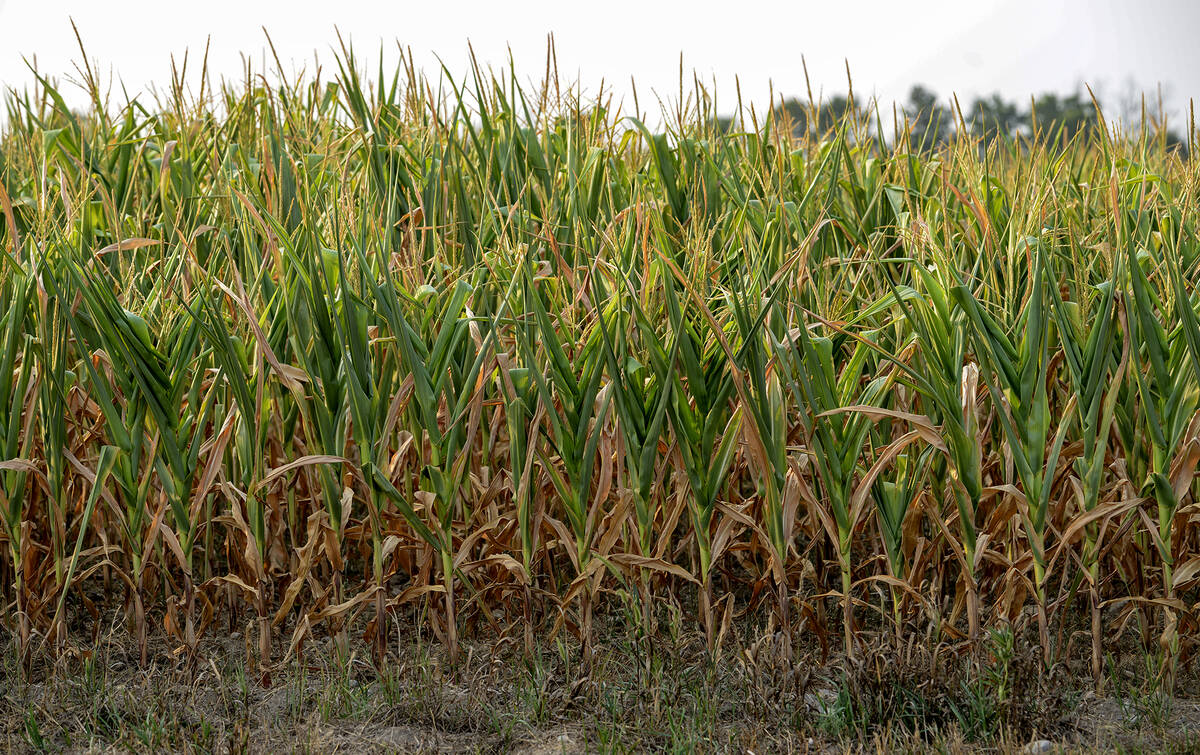The Ontario growing region received 85 to 115 per cent of normal precipitation in August and the southern region around Windsor had over 150 per cent of normal rainfall. Temperatures were 2 C to 3 C below normal.
For the most part, Ontario received normal precipitation with cooler than normal temperatures resulting in optimal conditions for corn and soybean development. Statistics Canada released its first crop estimate using a model-based survey. While yields were above year-ago levels for corn and soybeans, we believe upward revisions will be noted on the final producer survey in November.
Quick look
Soybeans: Export demand has improved for fall and winter periods.
Corn: It’s expected the U.S. will plant fewer corn acres next year and increase soybean acreage.
Wheat: Ontario soft red winter is competitively priced on the world market.
Read Also

Extreme variability marks Ontario’s 2025 corn crop
The yield potential of Ontario’s 2025 corn crop was lost in some areas due to extreme dry conditions.
Winter wheat yields were down from last year but up from the five-year average. Ontario soybean prices have strengthened over the past two weeks due to stronger export demand. Corn and wheat prices are relatively unchanged from two weeks earlier as the cereal grains move through seasonal lows. Quality issues are influencing the export potential for wheat.
During the last half of August, the U.S. Midwest received below normal rainfall. For the first half of September, the forecast calls for below normal precipitation and above average temperatures. The USDA will release its yield survey and production estimates Sept. 12. Traders and analysts are expecting yields to come in slightly lower than their August estimate, which should be supportive for the market.
Export demand for U.S. corn and soybeans has improved now that export offers are competitive with Brazilian origin for the fall period. The wheat complex appears to be making seasonal lows and is expected to trend higher in the latter half of September through October.
Wheat ending stocks for the seven major exporters will drop to a 16-year low in 2023-24. Russia has been dominating the world market but the export pace will slow later in winter due to quality issues of the winter wheat.
At the time of writing this article, the Canadian dollar was hovering at three-month lows. U.S. third quarter GDP is expected to reach four to five per cent, while Canadian economic growth will have a hard time reaching one per cent.
Average U.S. gas prices are lower than the average in Canada. Higher energy costs in Canada are providing a competitive disadvantage compared to our largest trading partner, especially for the manufacturing sector in central Canada.
China’s economic woes are worse than expected, which is also having a larger influence on the resource- based currency. Seasonally, the Canadian dollar trades sideways to lower during the fall, which should be supportive for Ontario grain and oilseed prices.
Soybeans
Statistics Canada’s model-based crop survey had the average soybean yield at 50.5 bu./acre, resulting in a production estimate of four million tonnes. This is up from last year’s yield of 48 bu./acre but down from the record of 51.6 bu./acre in 2021. Our contacts suggest soybean yields could break the 2021 record.
We feel comfortable with our crop projection of 4.2-4.3 million tonnes. Export demand has improved for the fall and winter periods, which has been driving local cash bids higher. The smaller U.S. crop has contributed to stronger offshore demand for Ontario soybeans. We’re also expecting a year-over-year increase in the Ontario crush pace as crush margins favour soybeans versus canola.
The Argentine soybean crop finished at 25 million tonnes, down 18 million tonnes from last year. Argentina is the world’s largest soymeal exporter. We’re seeing a transition of about three million tonnes of export soymeal demand from Argentina to the U.S. This is enhancing crush margins in the U.S. and Ontario.
World vegetable oil prices have also been percolating higher. In the U.S., the biodiesel component has been underpinning the vegetable oil market. On the export side, India experienced one of the driest Augusts on record, resulting in stronger vegetable oil imports. Argentine soyoil will also be down from year-ago levels.
The USDA was using an average yield of 50.9 bu./acre, resulting in a U.S. production number of 114.5 million tonnes. Given recent weather in August and the forecast for September, analysts are now using an average yield of 48 bu./acre. We’re expecting the U.S. soybean crop to finish in the range of 108-109 million tonnes, down from the 2022 output of 116.4 million tonnes and down from the five-year average of 113.8 million tonnes.
U.S. ending stocks for the 2023-24 crop year will be historically tight. This should result in higher prices later in winter. Secondly, the market will be extremely sensitive to Brazilian growing conditions. Keep in mind that Argentina remains on the drier side heading into the planting period.
What to do: We’ve advised Ontario farmers to be 100 per cent sold on old crop and 20 per cent sold on 2023 production. We’re planning our next sale in late October or early November, after North American harvest pressure has subsided. Given world fundamentals, the market could jump fairly sharply, especially if South America has a weather problem.
Corn
Statistics Canada’s model-based survey had the Ontario corn yield at 169.7 bu./acre, resulting in production of 9.6 million tonnes. In wet years, the model-based survey underestimates the yield and in dry years, it overestimates the yield.
We feel comfortable with our production estimate of 10.1 million tonnes, up from the year-ago output of 9.4 million tonnes and up from the five-year average of nine million tonnes. To reiterate from our previous issue, the 2022-23 ending stocks are estimated at 1.9 million tonnes, which will result in total supplies of 12 million tonnes. This is up from the 2022-23 starting point of 11.5 million tonnes and up from the five-year average of 11 million tonnes. The Ontario corn market will function to encourage demand during the first half of the crop year.
Ontario cattle on feed inventories are at seasonal lows during August and September. Feedlot cattle numbers generally peak in the winter. In a normal year, this correlates with the seasonal price pattern for corn in the first half of the crop year. The price pattern in the second half of the crop year is determined by export demand and South American production and exports.
The USDA estimated the average corn yield at 175.1 bu./acre on its August report. Given lower precipitation in August and the drier forecast for September, analysts now expect yields to drop to 172 bu./acre. This would result in a production estimate of 377 million tonnes, down from the August estimate of 384 million tonnes and up from the 2022 output of 349 million tonnes.
The main point is that the crop is getting smaller. Next spring, we’re anticipating lower U.S. corn acres due to an increase in soybean acres. This will cause the corn market to incorporate a risk premium due to uncertainty in production. Brazilian first crop corn acres could also be lower due to an increase in soybean acres, thereby lowering the exportable surplus in January through March.
The French corn crop is expected to be 11.2 million tonnes, up from the 2022 output of 10.8 but down from the 2021 crop of 15.5 million tonnes. This will be the second year of lower production. The year-over-year increase in European corn production is coming from Hungary and Romania. Therefore, Ontario corn will actively trade into Northern Europe in the latter half of the crop year.
French corn is quoted at US$245/tonne f.o.b. La Pallice, whereas Ontario corn is valued at US$225/tonne f.o.b. St. Lawrence port. Once the Eastern European surplus is absorbed, Northern European buyers will come for Ontario corn.
What to do: We’ve advised Ontario farmers to be 100 per cent sold on old crop and 20 per cent sold on expected 2023 production. Be patient to make further sales. We’re expecting stronger prices later in the crop year.
Wheat
Statistics Canada estimated the Ontario winter wheat yield at 89.7 bu./acre, resulting in a crop size of 2.6 million tonnes. This is up from the 2022 output of 2.2 million and up from the five-year average of 2.1 million tonnes.
Feed quality wheat is being priced into domestic feed channels and local millers are in the process of securing their 2023-24 requirements. We estimate there are about one million tonnes of wheat for export but quality parameters may limit offshore trade or movement into the U.S. Quality spreads will likely widen later in the crop year with noted premiums expected for milling quality.
Statistics Canada estimated non-durum spring wheat production at 22.1 million tonnes, down from the 2022 crop size of 25.8 million tonnes and down from the five-year average output of 23.6 million tonnes. The exportable supplies of non-durum spring wheat for the 2023-24 campaign are only expected to be 15 million tonnes, down from the 2022-23 exports of 19.7 million tonnes. Ontario spring wheat production is expected to come in at 126,000 tonnes, down from 158,000 tonnes last year.
U.S. No. 2 soft red winter wheat is priced at US$236/tonne f.o.b. the Gulf while French soft wheat is valued at US$254/tonne f.o.b. Rouen. Ontario soft red winter is valued at US$230/tonne f.o.b. St. Lawrence port. Ontario soft red winter is competitively priced on the world market, which will limit the downside for milling quality wheat.
We believe the wheat complex is moving through a seasonal low and higher prices are expected later in winter. Russia’s export pace is expected to slow later in winter. Traders report quality issues with the Russian wheat crop due to rains in July. Russia and India are apparently working on a trade deal of nine million tonnes. This will absorb a significant amount of Russia’s exportable surplus.
In late August, Egypt tendered for wheat and the lowest priced wheat was Romanian and French origin. This is a positive signal that Russia is not as aggressive on the world market. China’s wheat crop has serious quality issues after rains lowered quality during harvest. There is potential for China to be a major importer in 2023-24. The tide is turning on the wheat complex.
At the end of the 2023-24 crop year, combined ending stocks from the U.S., Europe, Australia, Argentina, Canada, Russia and Ukraine are expected to drop to 16-year lows, according to Reuters. The market needs to encourage acreage this fall when the Northern Hemisphere countries plant winter wheat. The market is a situation where it cannot afford a crop problem in 2024.
The September/ December Chicago wheat spread is trading near 30 cents/bu. This reflects a lack of demand in the short term. The May/July wheat spread is at nine cents/bu. This tells us that the fundamentals will tighten later in the crop year.
What to do: We continue to recommend that producers hold back on sales. Our first recommendation will likely occur in October and November. The tight fundamentals from major exporters are expected to result in stronger prices later in fall and winter.













